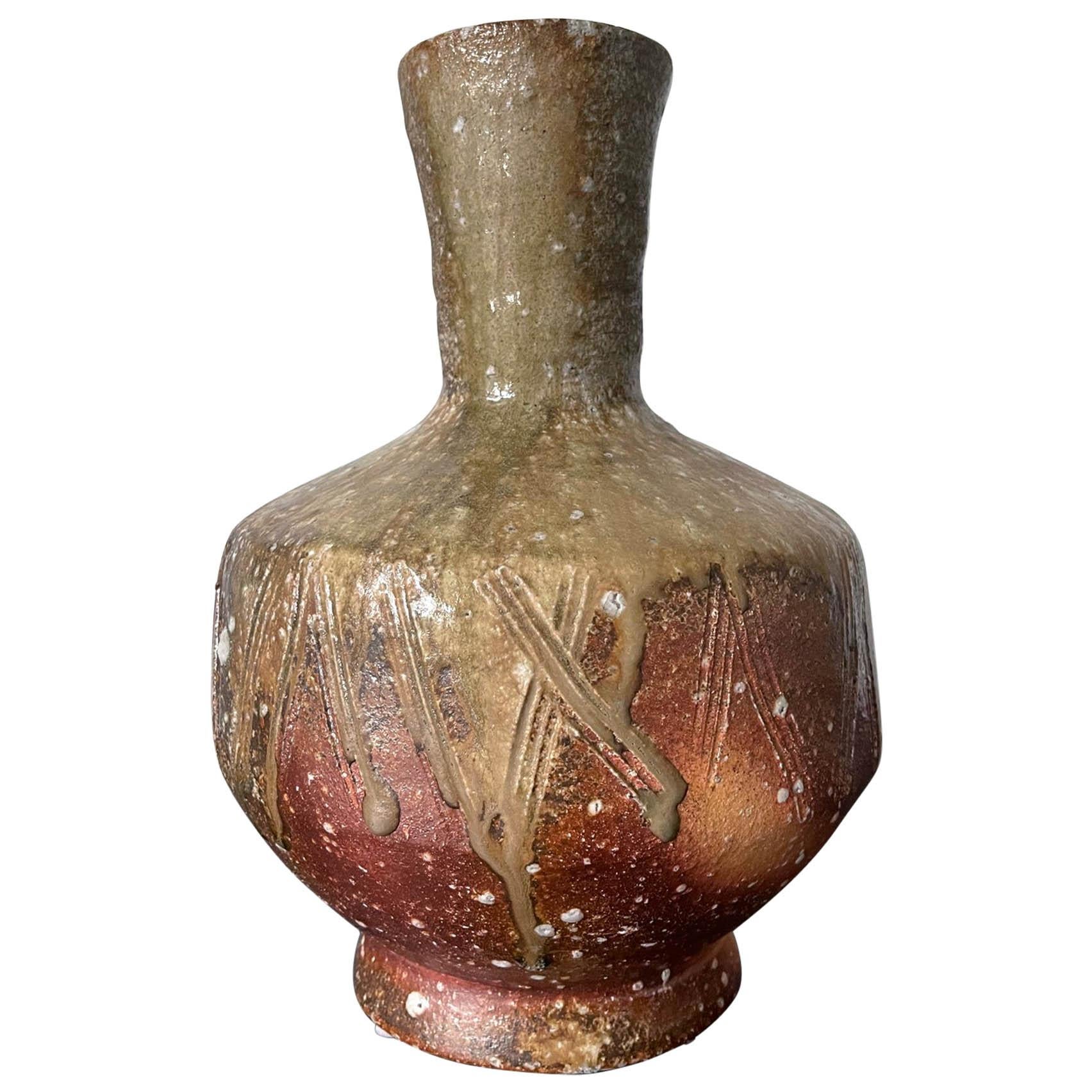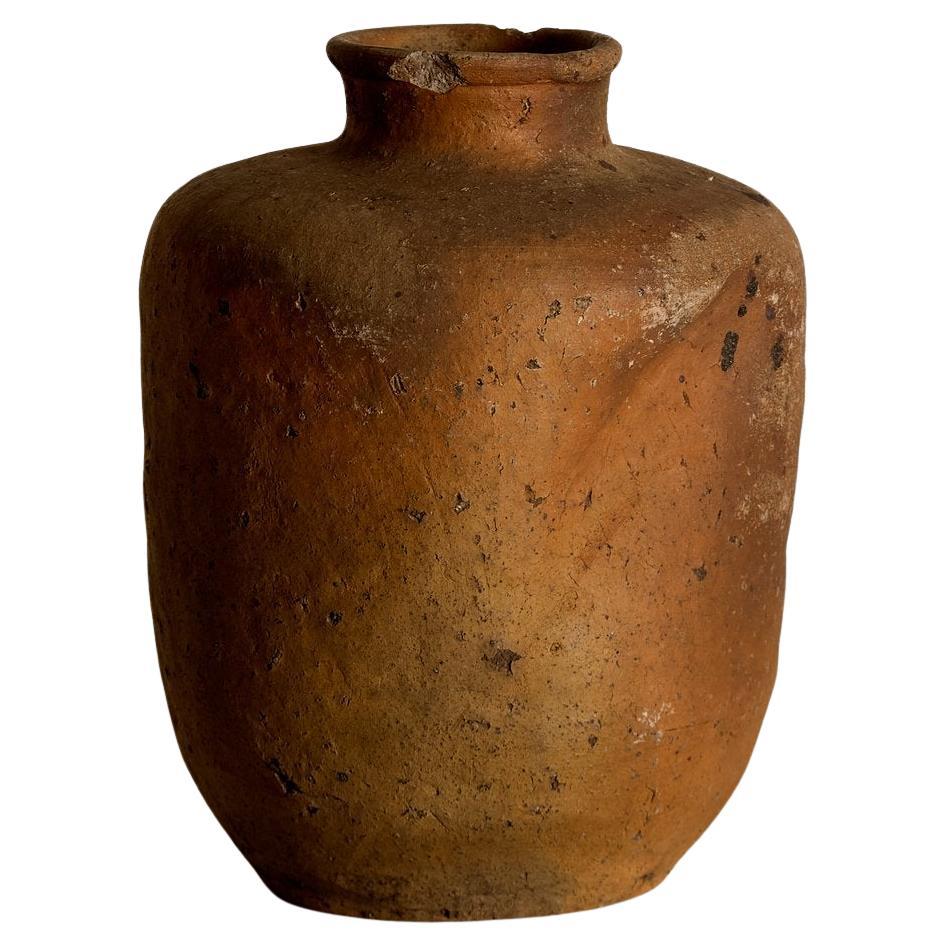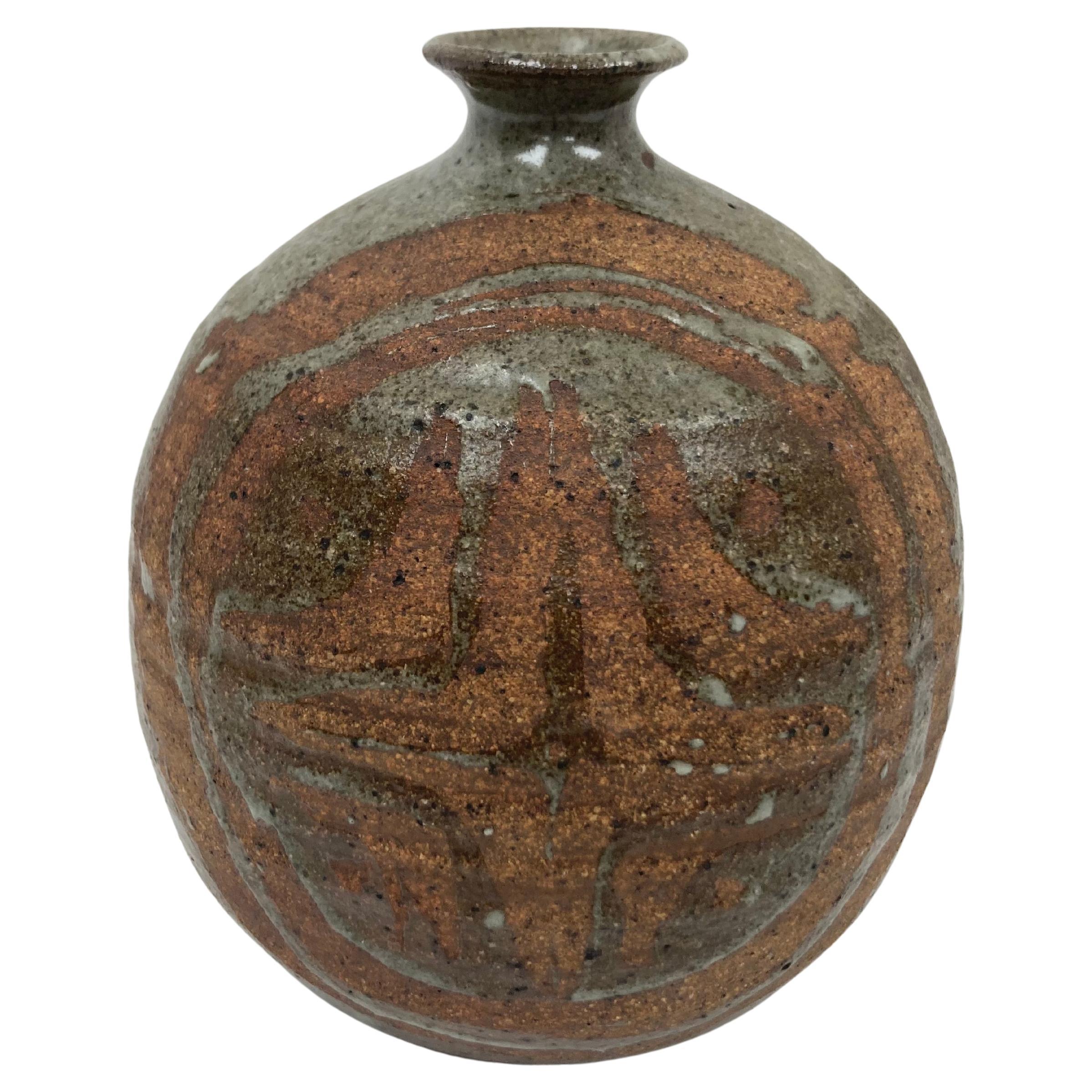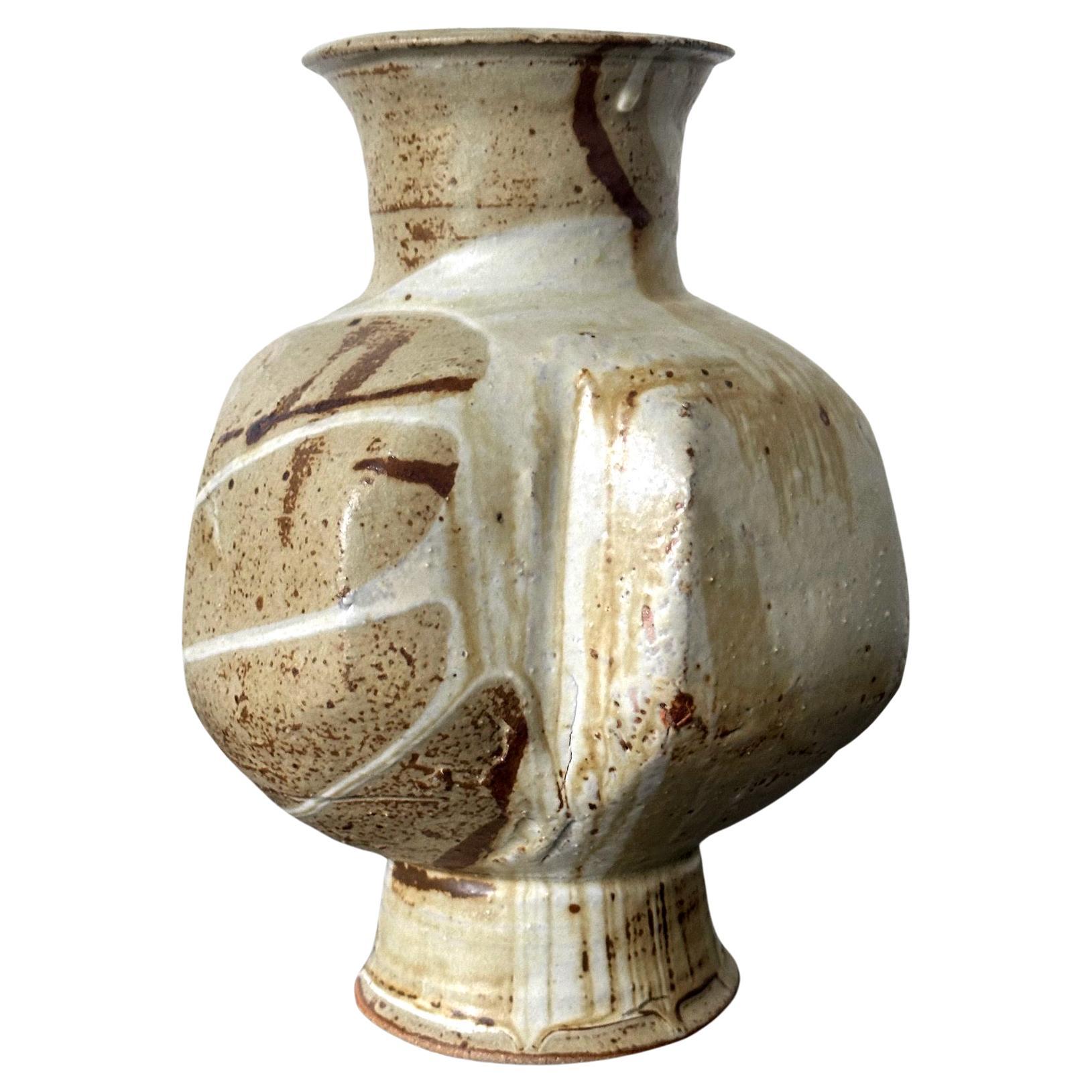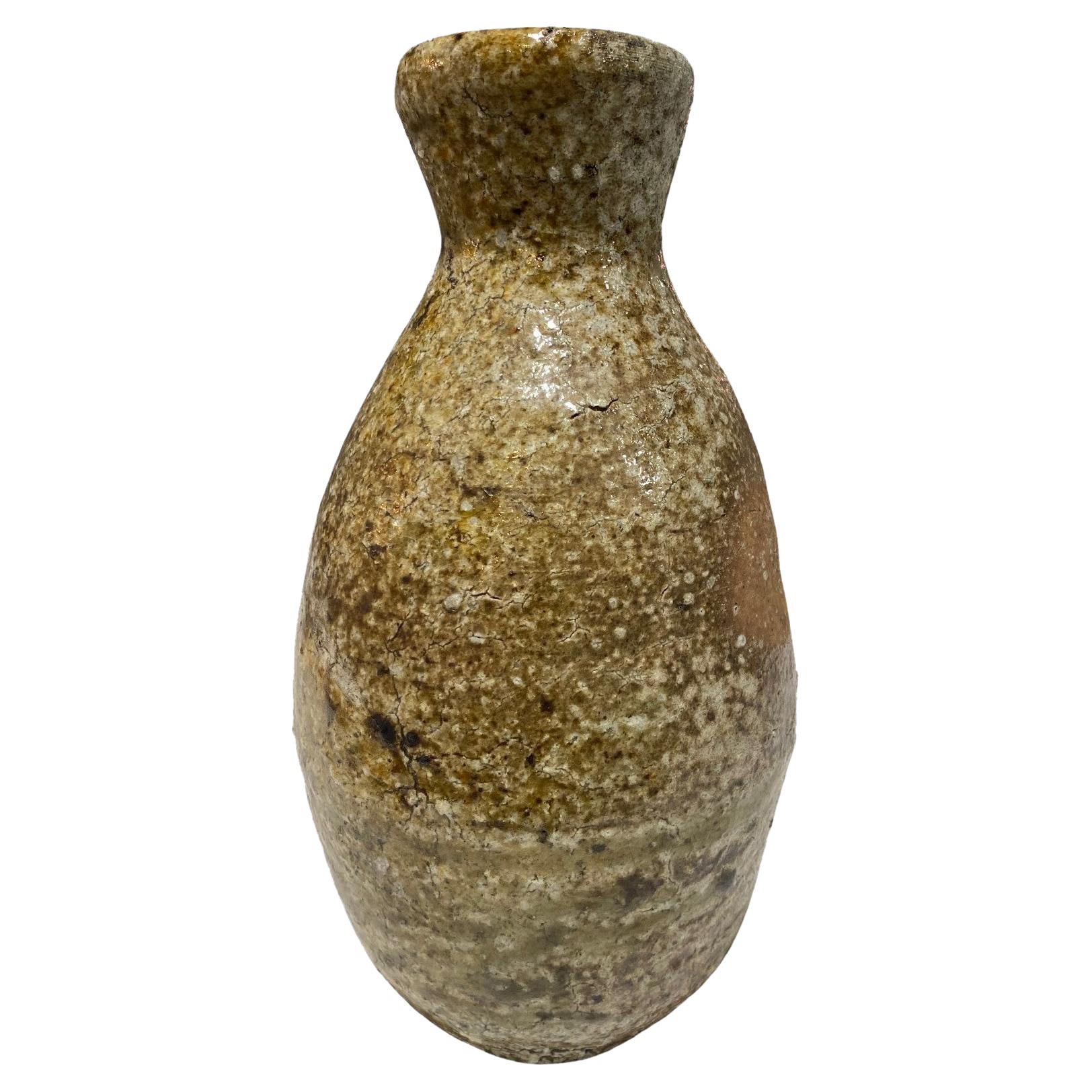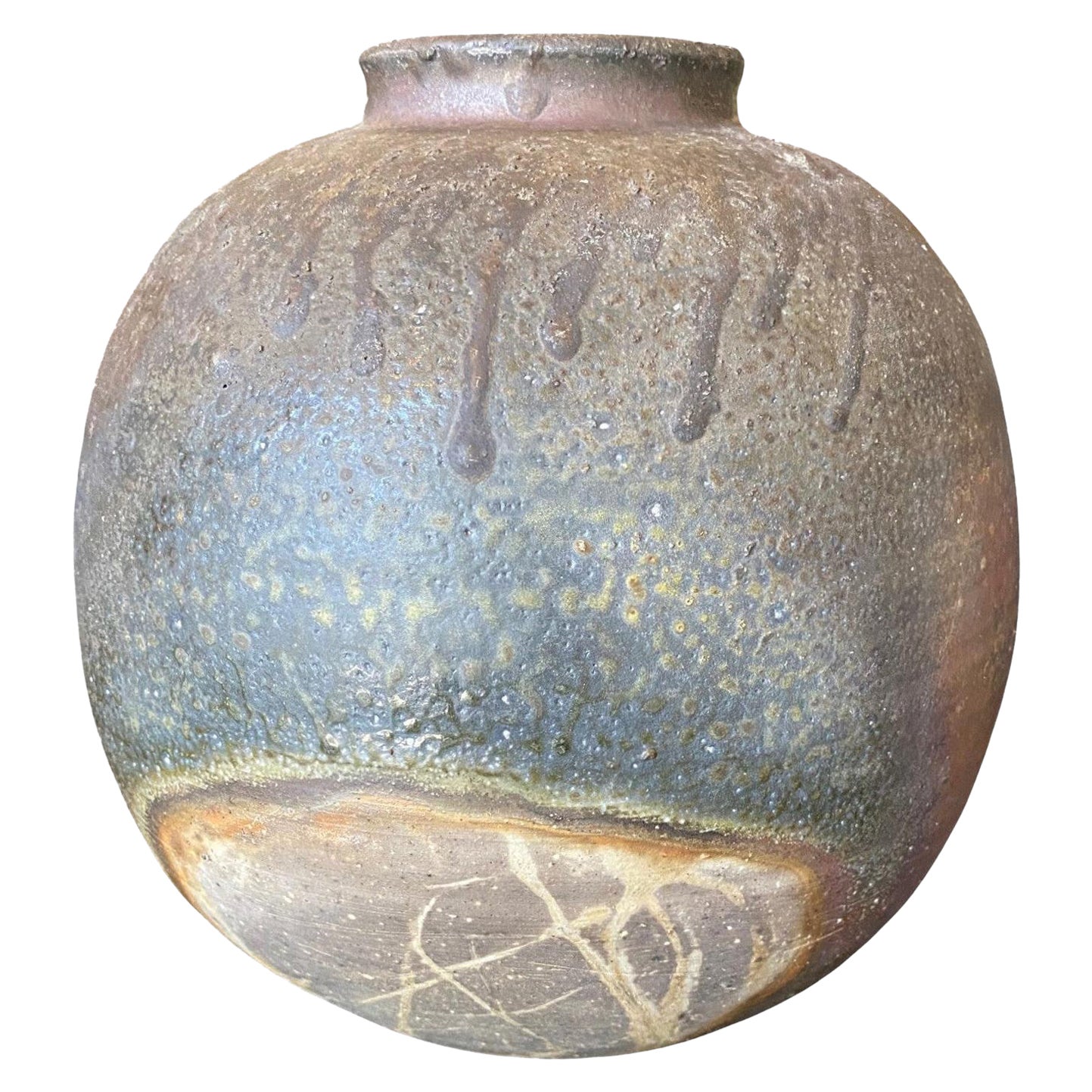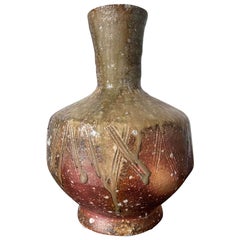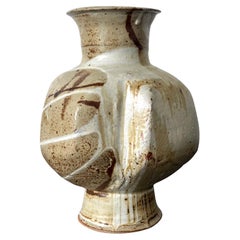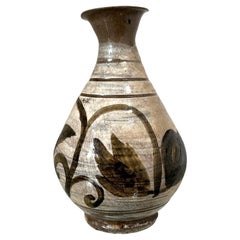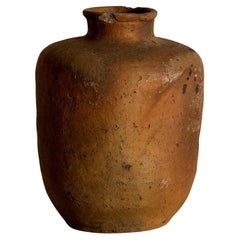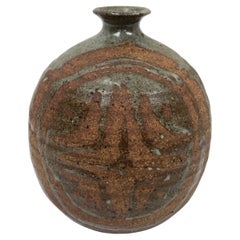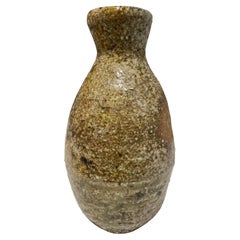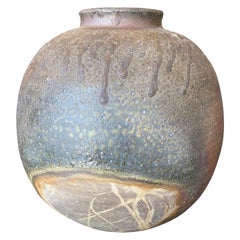Items Similar to Modern Studio Vase Bizen Ware by Jun Isezaki
Want more images or videos?
Request additional images or videos from the seller
1 of 15
Modern Studio Vase Bizen Ware by Jun Isezaki
$3,850
£2,922.85
€3,343.12
CA$5,379.01
A$5,982.63
CHF 3,123.94
MX$72,802.26
NOK 39,897.53
SEK 37,416.85
DKK 24,951
Shipping
Retrieving quote...The 1stDibs Promise:
Authenticity Guarantee,
Money-Back Guarantee,
24-Hour Cancellation
About the Item
A bottle form vase by Japanese studio ceramic artist Jun Isezaki (Born in 1936). A modern Bizen yaki stoneware piece that is strongly rooted in history and tradition, it takes a classic form of a robust body with slightly sloped shoulder that leads to a short neck and opening. Bizen yaki from Okayama is a unglazed stoneware, Isezaki employs a technique called''Hidasuki" (fire markings) to add surface decoration that happens by chance in the kiln. Featuring reddish lines across the brownish background of the body that appears modern and abstract, Hidasuki involves covering with piece with straws before firing. And the covered parts react with the component in the clay and produce the reddish color. The fire and air movement in the kiln often created ash patterns in an accidental way as evident on this piece. Marks of strokes, small splashes and fire-included clay explosion all found their destiny onto the surface including the base, rendering the piece a strong Wabi Sabi aesthetic.
Jun Isezaki is from a well established and famous lineage of potters in Bizen, Okayama. His father, Yozan Isezaki (1902-1961), was one of the finest saikumono (ornamental figure) potters, while his elder brother Mitsuru (1934- ), is one of its finest tea potters. Started in 1950s when Bizen ware was obscure, Isezaki's work raised larger awareness and popularity of the ware through the decades. Considered as one of the most renowned masters of Bizen pottery, Isezaki was honored with the title Living National Treasure by Japanese Agency for Cultural Affairs in 2004.
The vase comes in its original storage wood box with scripted title in Kanji as well as the artist's signature and seal.
Box: 12.5" x 7.25" x 7.25:". Vase; 9.5" height in x 5" diameter.
- Dimensions:Height: 9.5 in (24.13 cm)Diameter: 5 in (12.7 cm)
- Style:Organic Modern (Of the Period)
- Materials and Techniques:
- Place of Origin:
- Period:
- Date of Manufacture:Second Half of the 20th Century
- Condition:Wear consistent with age and use. Original studio condition with intended surface characters. Wood box with little age wear.
- Seller Location:Atlanta, GA
- Reference Number:1stDibs: LU945023566432
About the Seller
4.9
Platinum Seller
Premium sellers with a 4.7+ rating and 24-hour response times
Established in 2006
1stDibs seller since 2010
564 sales on 1stDibs
Typical response time: <1 hour
- ShippingRetrieving quote...Shipping from: Atlanta, GA
- Return Policy
Authenticity Guarantee
In the unlikely event there’s an issue with an item’s authenticity, contact us within 1 year for a full refund. DetailsMoney-Back Guarantee
If your item is not as described, is damaged in transit, or does not arrive, contact us within 7 days for a full refund. Details24-Hour Cancellation
You have a 24-hour grace period in which to reconsider your purchase, with no questions asked.Vetted Professional Sellers
Our world-class sellers must adhere to strict standards for service and quality, maintaining the integrity of our listings.Price-Match Guarantee
If you find that a seller listed the same item for a lower price elsewhere, we’ll match it.Trusted Global Delivery
Our best-in-class carrier network provides specialized shipping options worldwide, including custom delivery.More From This Seller
View AllModern Japanese Ceramic Shigaraki Ikebana Vase Takahashi Shunsai
Located in Atlanta, GA
A tall ceramic vase made in the tradition of Shigaraki ware by Japanese potter Takahashi Shunsai (1927-2011), the fourth heir of the famed Rakusai lineage of potters. The vase is heavily potted in the reddish sandy Shigaraki clay. It has a Classic vase form made for Ikebana display. The surface is thickly draped with natural ash glaze that deposited onto the body during the firing process in the kiln. It also features decoration of carved lines. Nuggets of feldspar were incorporated in the clay and exposed onto the surface as crystal like jewels. Substantial and archaic looking, the vase also has a strong modern appeal due to its Mingei styling. It was signed on the base with a pressed seal Shunsai as shown. The vase comes with its original wood storage box (tomobako) with bears the title and signature in Kanji and a seal. It also retains a paperwork noting the artist's biography and practice philosophy in Japanese.
Born in Shigaraki, Shunsai was the second son of renowned potter Takahashi Rakusai...
Category
1990s Japanese Modern Ceramics
Materials
Ceramic
Ceramic Vase with Bespoken Glaze by Makoto Yabe
By Makoto Yabe
Located in Atlanta, GA
Made by Japanese ceramic artist Makoto Yabe (1947-2005), this stoneware vase features a globular body supported by a round pedestal foot. A similarly shaped neck extends to a rimmed mouth opening. Robust in form with thick wall, the vase is noted for its irregular cloved form. The surface is covered in a beige-yellow glaze, on top of which, dark brown strokes and thick white feldspar slip were artistically applied in a splashed and washed pattern. Together with some random shallow incision lines, they form an abstract painting with textured surface where some slip forms small droplets at the end of the stroke. The work was created in traditional Japanese manner and reflects the beauty of Wabi Sabi, a Zen aesthetic for the imperfect perfection.
The base was incised with the artist's cipher.
"Makoto Yabe's work beautifully exemplifies the transmission of Japanese ceramics to the West. Born in Fukushima, Japan, Yabe began studying ceramics in Kyoto at the age of nine. He completed his training at the age of 24, with a four-year apprenticeship under Jinmatsu Uno and Sango Uno. Yabe then came to Boston, where he was an integral member of the local ceramic community, yet he maintained his Japanese roots. As an instructor of ceramics, Yabe worked in the Boston area at numerous schools and universities, touching the lives of all his students and expanding their knowledge and appreciation of studio ceramics."
Biography sited from Pucker Gallery...
Category
Late 20th Century American Organic Modern Ceramics
Materials
Ceramic, Stoneware
Japanese Ceramic Vase Mingei Style Hamada Shoji
By Hamada Shoji
Located in Atlanta, GA
A heavily potted stoneware vase in cylindrical form, decorated with abstract strokes in iron rust glaze (known as Persimmon Glaze in Japanese) on a black glazed background. The pattern suggests autumn grasses, and it was applied with free hands. The vase is attributed to Japanese potter Hamada Shoji...
Category
Late 20th Century Japanese Arts and Crafts Ceramics
Materials
Ceramic
Korean Glazed Ceramic Vase Buncheong Ware Joseon Dynasty
Located in Atlanta, GA
A small antique Korean Buncheong stoneware vase from early Joseon Dynasty circa 16th century. The vase is of a classic pear form with a waisted neck, a flared mouth and a ringed base...
Category
Antique 16th Century Korean Other Ceramics
Materials
Ceramic
Asian Flambe Studio Pottery Vase
By Kyoto Pottery
Located in Atlanta, GA
A garlic bottle vase in an archaic Chinese form, but likely Japanese in origin. Several circumventing grooves however, suggest a more modern age. It was done in a brilliant purple glaze over a robin egg blue background glaze. The bubbling and bursting effects during the firing renders the surface an artistic spotting effect. The color pallet recalls the Classic Jun Yao...
Category
Antique Late 19th Century Japanese Japonisme Ceramics
Materials
Ceramic
Japanese Ceramic Sake Bottle Chosen Karatsu Ware
Located in Atlanta, GA
The long neck bottle of classic form was heavily potted with coarse clay with high iron content. The flask, circa 18th century Edo period, was purposed for sake storage but also substituted as a flower vase during tea ceremony. The surface is covered in glossy black glaze and contrasts strikingly with white ash glaze around the shoulder. The white, fired with straw, displays a splashing feather effect and fine crackles, blending in with the black artistically. This type of Karatsu ware...
Category
Antique 18th Century Japanese Japonisme Ceramics
Materials
Ceramic
You May Also Like
Wabi Sabi Japanese Stoneware Vase, Kasama, 1960s
Located in London, England
Japanese hand built stoneware vessel.
Playfully dented prior to firing.
Textured speckle glaze.
Kasam, Japan 1960s.
H 34cm x D 27cm
Category
Mid-20th Century Asian Anglo-Japanese Vases
Materials
Stoneware
Studio Pottery Vase in Asian Style
Located in Bridgeport, CT
A very well crafted globular form glazed pottery Vase in Asian style. Reminiscent of Green Tea Ceremony vessels, the vase has a pleasing ridged body, irregular Olive Grey and Celadon...
Category
20th Century Edo Vases
Materials
Clay
Sugimoto Sadamitsu Signed Japanese Shigaraki Pottery Wabi-Sabi Art Vase
Located in Studio City, CA
A quite wonderful Shigaraki pottery vase by renowned Japanese potter/ceramicist and Zen master Sugimoto Sadamitsu (1935-). Born in Tōkyō in 1935, Sug...
Category
20th Century Japanese Showa Ceramics
Materials
Stoneware
Izuru Yamamoto Japanese Bizen Ware Pottery Yohen Tsubo Jar Vase With Ash Glaze
Located in Studio City, CA
A stunning and sumptuously, naturally glazed large work by Japanese pottery master Izuru Yamamoto (Born 1944- He is the son of the late Toshu Yamamoto- a Japanese Living National Tr...
Category
21st Century and Contemporary Japanese Ceramics
Materials
Pottery, Stoneware
Jun Isezaki Signed Japanese Bizen Yaki Ware Pottery Large Vase Signed Sealed Box
Located in Studio City, CA
A wonderfully made large Bizen Yaki Ware vase by famed Japanese Bizen pottery master artist Jun (Jyun) Isezaki (born 1936) who was designated a Japanese Living National Treasure in 2...
Category
Mid-20th Century Japanese Showa Ceramics
Materials
Earthenware, Pottery
Kaneshige Toyo National Treasure Signed Japanese Bizen Pottery Sake Bottle Vase
Located in Studio City, CA
A beautiful, perfectly shaped and balanced antique Bizen ware shibui sake bottle (tokkuri) vase by renowned Japanese master potter/artist Kaneshige Toyo (1896-1967) featuring a unique natural, wonderfully textured organic forming ash glaze. Kaneshige is universally considered to be the founder of modern Bizen pottery.
In 1956, Kaneshige was certified as a Living National Treasure (Important Intangible Cultural Heritage) for his work in Bizen Ware pottery/ceramics. Bizen Ware is a type of Japanese pottery traditionally from the Bizen province, presently a part of the Okayama prefecture. It is considered one of the Six Ancient Japanese Kilns (along with Echizen ware, Seto ware, Shigaraki ware, Tamba ware, and Tokoname ware).
The piece is signed/ sealed on the base with one of Kaneshige's traditional incised marks.
A rather striking and engaging work. One of the best Kaneshige works we have come across. Scarce and hard to find in such an excellent condition. Would be a fantastic addition to any Japanese/Asian pottery or Bizen Ware collection or eye-catching stand-alone work in about any setting.
Kaneshige's work can be found in numerous prominent collections and museums including:
Aichi Prefectural Ceramic Museum, Seto, Japan
Brooklyn Museum, NY
Hagi Uragami Museum, Yamaguchi, Japan
Honolulu Art Museum, HI
Ibaraki Ceramic Art Museum, Kasama, Japan
Indiana Art...
Category
Mid-20th Century Japanese Showa Ceramics
Materials
Stoneware
